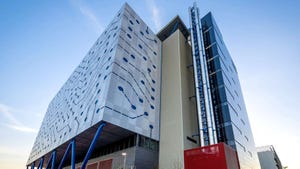
Insight and analysis on the data center space from industry thought leaders.
Dynamic Operations: Safeguard Your Data Center With CFD Simulation SoftwareDynamic Operations: Safeguard Your Data Center With CFD Simulation Software
Computational Fluid Dynamics (CFD) software can help data centers anticipate cooling failures and optimize energy efficiency. Gordon Johnson takes a closer look at this powerful data center tool.
August 21, 2024

What happens if critical components within a data center, such as cooling units, fail unexpectedly? And what if an entire cooling system fails at once due to a power outage or a major event, like a breakdown at the chilled water plant? The solution lies in using Computational Fluid Dynamics (CFD) modeling and simulation, leveraging software tailored specifically for data center environments.
The recent rise in AI has led to vast amounts of computational power and data storage being required. This has led to a significant increase in the need for high-performance servers capable of handling complex tasks, pushing data centers to adopt a more robust infrastructure. However, promises to invest in AI products are clashing directly with assurances to reduce CO2 emissions.
Even tech giants such as Google, Amazon, and Microsoft admit their net-zero targets are in jeopardy. Google recently revealed that its greenhouse gas emissions had risen 48% over the past five years and that electricity consumption by data centers, alongside supply chain emissions, were the primary cause of the increase, endangering its goal of being carbon-neutral by 2030.
The International Energy Agency has estimated that data centers’ total electricity consumption could double from 2022 levels to 1,000 terawatt hours in 2026, with AI resulting in data centers using 4.5% of global energy generation by 2030, according to calculations by research firm SemiAnalysis.
As power and heat loads continue to rise, efficient cooling in the data center is becoming more and more challenging. Cooling is responsible for up to 40% of a data center’s total energy consumption. In addition, data center thermal management is often a reactive process, meaning we tend to wait for server alarms or increased server inlet temperatures before we react.
Key Benefits of CFD Simulation for Data Centers
Data center CFD software creates a 3D model or digital twin of the physical attributes of the facility, including the performance characteristics of the cooling units, information technology equipment (ITE), and other significant equipment, described by some as an MRI of what is really happening inside the data center.
CFD provides a detailed understanding of the complex interactions between airflow, heat removal from the ITE, and cooling systems. This enables data center operators to make informed decisions to reduce energy consumption and improve overall cooling efficiency.
The key benefits of using CFD software include, but are not limited, to:
Identifying potential server ‘hot spots’
Validating the pre-construction phase of a data center
Correctly placing additional ITE and cooling units in existing data centers
Optimizing airflow and reducing excess and unnecessary cooling
Simulating via transient modeling the ITE ride-out time due to power and/or cooling system failure.
Data Center CFD Software as a Design Tool
CFD software can aid in the design phase of data centers by simulating a variety of layout configurations. It looks at the placement of servers, racks, cooling units, and airflow containment systems to ensure optimal thermal performance, starting with the design phase down to the operational phase of the data center. This means that designs can be validated by avoiding and preventing costly mistakes.
However, CFD is not just for new design. Legacy data centers can also take advantage of the software through simulating the results of proposed changes to the existing room layout such as capacity redistribution or ITE expansion. In all cases, a CFD allows data center operators to make data-based informed decisions while minimizing or eliminating critical potential equipment downtime.
A CFD also accurately simulates and provides a detailed analysis of airflow and temperature distribution at all stages of the cooling process. These patterns include temperature distribution in both cold and hot aisles, in addition to the temperature across the server inlets from the bottom to the top of the racks.
Data center CFD simulations further evaluate the performance of different cooling strategies. For example, it can simulate air cooling strategies deployed in conjunction with liquid cooling designs, such as those using air cooling to remove the supplemental ITE heat not removed via the circulating liquid in Direct-to-chip cold plate cooling.
Additionally, CFD now can accurately reduce risk from power and cooling system failure with transient modeling, showing via time increments what will happen to the ITE when either cooling is lost or both cooling and fan power (airflow) fail.
When both cooling and fan power fails throughout the data center, cooling is not lost immediately since the fans will take some time to come to a complete stop. CFD can simulate this period, showing how hot the ITE server inlets will get and how soon this will happen before power is restored to the data center.
How CFD Can Reduce Data Centers’ Carbon Footprint
The growing focus on data center sustainability has highlighted our need to work towards energy-efficient designs, recognizing the need to reduce our energy footprint while maintaining safe and optimal operating temperatures at the ITE.
CFD software assists with this important endeavor by identifying server hot spots before they occur. This results in reduced downtime and improved overall ITE reliability.
The software further aids in extending the lifespan of the ITE by ensuring it operates within the American Society of Heating, Refrigeration, and Air-Conditioning Engineers’ recommended thermal temperature guidelines. This way, potential issues can be addressed before they lead to costly problems, improving both the overall reliability and uptime of the data center.
The Challenges of Implementing Data Center CFD Systems
Implementing CFD into existing data center management processes is not without its challenges. As with any analytical tool, the accuracy of assessments and simulations depends on the quality of the data used.
For accurate modeling, a baseline of how the data center is currently operating is crucial for reliable results, and this should include current rack kW, cooling unit supply and return temperatures, rack and room leakage, as well as other additional room and airflow characteristics.
Data center experts agree that all new data centers should always perform a CFD before construction, while existing data centers should also perform a CFD before making any ITE and cooling changes for design validation.
Despite these challenges, real-world case studies and success stories highlight the impact of CFD in data center optimization by demonstrating significant improvements in energy efficiency, cooling effectiveness, and operational performance.
In the future, we expect to see CFD used extensively with the integration of machine learning, AI, ITE, and hybrid cooling infrastructure designs, with a continued priority on sustainability.
Modeling for Success
CFD modeling is a powerful tool for designing and validating efficient technology solutions for new and legacy data center environments by providing predictive results that bridge high-performance computer server operations with the critical mechanical system.
It also safeguards the data center by simulating failure scenarios that enable data center managers to better understand and design the appropriate redundancy for power and cooling failure scenarios.
Using CFD is one of, if not the, most important step in determining data center energy efficiency since it provides a detailed understanding of the complex interactions between airflow, heat, and cooling systems. This enables data center operators to make informed decisions to reduce both energy consumption and the data center’s carbon footprint.
Gordon Johnson is the Senior CFD Engineer at Subzero Engineering, responsible for planning and managing all CFD-related jobs in the US and worldwide.
He has over 25 years of experience in the data center industry which includes data center energy efficiency assessments, CFD modeling, and disaster recovery. He is a certified US Department of Energy Data Center Energy Practitioner (DCEP), a certified Data Centre Design Professional (CDCDP), and holds a Bachelor of Science in Electrical Engineering from New Jersey Institute of Technology.
Read more about:
North AmericaAbout the Author
You May Also Like









